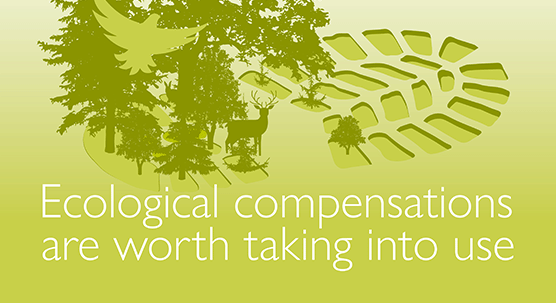
In ecological compensation local damage caused by construction or industry is offset by improving biodiversity elsewhere. The principle is that the compensation is paid by the one that causes the damage. The SYKE Policy Brief published today states that legislation is needed to create rules for the compensation. The publication is aimed at decision-makers and companies.
Diversity in nature is in a continuing global decline and new means are needed to stop the biodiversity loss. In Finland, there is interest for the development of ecological compensations, as the piloting of compensations has been included in the Government Programme of the spring of 2019.
Compensation is worth taking into use in situations in which damage inflicted on nature by humans cannot be completely avoided. An offset can take the form of managing traditional agricultural environments or restoring drained swamps, for example. The principle should be that the compensation is paid for by the one who causes the damage. The cost of compensation can be added to the prices of products.
Compensation rules that define the rights and responsibilities of both the one causing ecological damage and the offset producer should be created through legislation. The compensation practices must be transparent. Developing the best solutions requires carefully enacted piloting.
Putting the benefits to nature first in ecological compensation
Planning and piloting compensations should be made with the good of nature in mind. “The compensation measures can be beneficial for biodiversity if they are genuinely new - that is, if they are the kind for which no other obligations yet exist. This is referred to as the additionality principle. Following the additionality principle means that compensation must not be used to replace existing policies, steering methods, or good practices for securing biodiversity”, explains Minna Pekkonen, Coordinator at the SYKE Biodiversity Centre.
The suitability of different habitat types for ecological compensation in Finland has been assessed in SYKE “The design of ecological compensation must be based on knowledge of the extent of the threat facing the habitat and its rarity, and the skills required, and the methods involved in its restoration. Each compensation case needs careful and case-specific planning and consideration. Compensatory offsets can be best produced in habitats for which knowledge already exists for their restoration or management. For example, many threatened types of meadows are estimated to be well-suited for producing offsets, because their management can improve the viability of their flora and fauna and prevent them from becoming overgrown”, says Anne Raunio, Head of Unit at the SYKE Biodiversity Centre.
There are also rare habitats and individual, unique nature sites whose loss cannot be offset by compensation.
The offset areas should be located in a way that supports the existing network of protected areas.
Damage from hydroelectric plants can be compensated
“The implementation of ecological compensation could also produce concrete benefits in flowing waters. The restoration of natural flows, the construction of new habitats, and other types of restoration methods would boost the fish stocks of flowing waters and increase biodiversity”, says Saija Koljonen Senior Research Scientist at the SYKE Freshwater Centre. “To the extent that the harm caused by these power plants cannot be reduced on the spot, the restoration of a natural flow in other waterways, for example by dismantling dams that are less important for the production of hydroelectric power, might be a suitable means of ecological compensation. This would require legislative changes.”
Among the major threats to biodiversity are changes in land use . Compensation alone cannot stop the biodiversity loss, but evaluating the need for compensation sheds light on the harm inflicted on nature by human activity. This, combined with costs of compensation, can serve as an incentive to avoid causing damage in the first place. The use of ecological compensation would, for its part, support a move toward more sustainable utilisation of natural resources and land use.
Further information
Minna Pekkonen, Coordinator, SYKE Biodiversity Centre
firstname.lastname@ymparisto.fi, +358 295 251 779
Anne Raunio, Head of Unit, SYKE Biodiversity Centre
firstname.lastname@ymparisto.fi, +358 295 251 547
Saija Koljonen, Senior Research Scientist, SYKE Freshwater Centre
firstname.lastname@ymparisto.fi, +358 295 251 791
SYKE policy Brief: Ecological compensations are worth taking into use
FIBS and SYKE, together with the Ministry of the Environment, have organised various environmental responsibility training events for several years. The next event will be Introduction to Business for Nature on 21 November.
All SYKE Policy Briefs
SYKE Policy Briefs are concise summaries of a particular issue, the policy options to deal with it, and some recommendations on the best option. It is aimed at government policymakers and others who are interested in formulating or influencing policy.